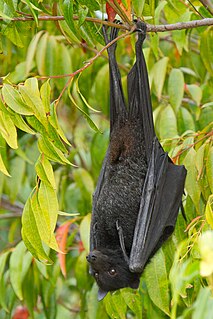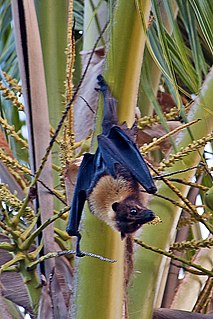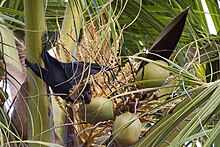
Megabats constitute the family Pteropodidae of the order Chiroptera (bats). They are also called fruit bats, Old World fruit bats, or—especially the genera Acerodon and Pteropus—flying foxes. They are the only member of the superfamily Pteropodoidea, which is one of two superfamilies in the suborder Yinpterochiroptera. Internal divisions of Pteropodidae have varied since subfamilies were first proposed in 1917. From three subfamilies in the 1917 classification, six are now recognized, along with various tribes. As of 2018, 197 species of megabat had been described.

Pteropus is a genus of megabats which are among the largest bats in the world. They are commonly known as fruit bats or flying foxes, among other colloquial names. They live in the South Asia, Southeast Asia, Australia, East Africa, and some oceanic islands in the Indian and Pacific Oceans. There are at least 60 extant species in the genus.

The black flying fox or black fruit bat is a bat in the family Pteropodidae. It is among the largest bats in the world, but is considerably smaller than the largest species in its genus, Pteropus. The black flying fox is native to Australia, Papua New Guinea, and Indonesia. It is not a threatened species.

The Vanuatu flying fox or white flying fox is a species of flying fox in the family Pteropodidae. It is endemic to Vanuatu. It is most closely related to the Samoa flying fox.

The Banks flying fox is a species of megabat in the family Pteropodidae. It is endemic to Vanuatu. Its natural habitats are subtropical or tropical dry forests and subtropical or tropical swamps. These small fruit bats are about 15 cm. long with grey and brown on its head and back with a yellow-orange neck and yellow-gray bellies. Its diet consists of coconut flowers and Vaveli trees fruit since its home is tropical.

The white-winged flying fox, also known as the mottle-winged flying fox is a species of bat in the family Pteropodidae. They are endemic to the Philippines. Their natural habitat is subtropical or tropical dry forests. They are threatened by habitat loss. In 2008, Giannini et al. revived the genus Desmalopex and placed D. leucopterus in it.

The Temotu flying fox is a species of flying fox in the family Pteropodidae. It is endemic to the Solomon Islands. It is threatened by habitat destruction due to subsistence agricultural practices, as well as natural disasters such as tropical cyclones. Due to its imperiled status, it is identified by the Alliance for Zero Extinction as a species in danger of imminent extinction. In 2013, Bat Conservation International listed this species as one of the 35 species of its worldwide priority list of conservation.

The Ceram fruit bat or Seram flying fox is a species of megabat in the family Pteropodidae. It is endemic to the mountainous forests of two Indonesian islands, Buru and Seram, including the Manusela National Park on Seram. They were once present on the nearby Ambon Island, but probably not anymore. The habitat has an area of less than 20,000 km2, and is decreasing due to logging. For this reason, and because of hunting by the local population, these species are listed as vulnerable by the IUCN since 1996.

Pteropus pelagicus is a species of fruit bat in the family Pteropodidae. It includes two subspecies that were formerly recognized as full species— Pteropus insularis and Pteropus phaeocephalus. It is endemic to Micronesia. It is threatened by habitat loss.

The Samoa flying fox or Samoan flying fox is a species of flying fox in the family Pteropodidae. It is found in American Samoa, Fiji, and Samoa. Its natural habitat is subtropical or tropical dry forests. It is threatened by habitat loss.

The Vanikoro flying fox, also known locally as basapine, is a species of bat in the family Pteropodidae. It has only been found in the Vanikoro island group located in the southern Solomon Islands. The species as a whole was originally known from just a few specimens collected sometime before 1930 but following surveys conducted on the island in the early 1990s did not detect this species again causing the Vanikoro flying fox to be listed as extinct. However, the species was rediscovered by a survey conducted in late 2014 which indicated a population in the high hundreds or low thousands and reported all observations.

The dwarf flying fox, least flying fox, or least fruit bat is a species of flying fox in the family Pteropodidae. It is endemic to the Solomon Islands. It is threatened by deforestation, which is believed to damage roosting sites in old growth forests.

The Rennell flying fox is a species of flying fox found in the Solomon Islands. It is an endangered species risking extinction.

The big-eared flying fox is a species of bat in the family Pteropodidae, larger bats who subsist largely on fruits. The species is distributed across a range in Indonesia, Papua New Guinea and islands nearing the Cape York peninsula at the northeast of Australia, at elevations less than 500 metres and often in coastal mangroves.
The large Samoan flying fox is a species of fruit-eating megabat whose type specimen was originally collected in Samoa in 1856, but was not identified as a new species until 2009. The only known specimen was collected by an American expedition to Samoa in 1838–1842. It was rediscovered by Smithsonian mammalogist Kristofer Helgen preserved in alcohol. It was the largest known bat from Polynesia. As the type specimen is dead, and no other examples of the species are known, it is believed to be extinct.
















